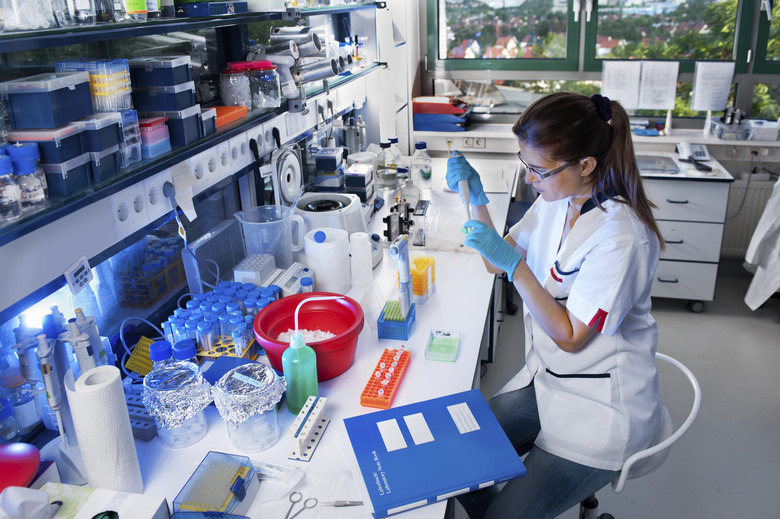Steps & Procedures For Conducting Scientific Research
A good scientist practices objectivity to avoid errors and personal biases that may lead to falsified research. The entire scientific research process–from defining the research question to drawing conclusions about data–requires the researcher to think critically and approach issues in an organized and systematic way. Scientific research can lead to the confirmation or re-evaluation of existing theories or to the development of entirely new theories.
Defining Problem and Research
Defining Problem and Research
The first step of the scientific research process involves defining the problem and conducting research. First, a broad topic is selected concerning some topic or a research question is asked. The scientist researches the question to determine if it has been answered or the types of conclusions other researchers have drawn and experiments that have been carried out in relation to the question. Research involves reading scholarly journal articles from other scientists, which can be found on the Internet via research databases and journals that publish academic articles online. During research, the scientist narrows down the broad topic into a specific research question about some issue.
Hypothesis
Hypothesis
The hypothesis is a concise, clear statement containing the main idea or purpose of your scientific research. A hypothesis must be testable and falsifiable, meaning there must be a way to test the hypothesis and it can either be supported or rejected based on examining data. Crafting a hypothesis requires you to define the variables you're researching (e.g., who or what you're studying), explain them with clarity and explain your position. When writing the hypothesis, scientists either make a specific cause-and-effect statement about the variables being studied or make a general statement about the relationship between such variables.
Design Experiment
Design Experiment
Designing a scientific experiment involves planning how you're going to collect data. Often, the nature of the research question influences how the scientific research will be conducted. For example, researching people's opinions naturally requires conducting surveys. When designing the experiment, the scientists selects from where and how the sample being studied will be obtained, the dates and times for the experiment, the controls being used and the other measures needed to carry out the research.
Collect Data
Collect Data
Data collection involves carrying out the experiment the scientist designed. During this process, the scientists record the data and complete the tasks required to conduct the experiments. In other words, the scientist goes to the research site to perform the experiment, such as a laboratory or some other setting. Tasks involved with conducting the experiment vary depending on the type of research. For example, some experiments require bringing human participants in for a test, conducting observations in the natural environment or experimenting with animal subjects.
Analyze Data
Analyze Data
Analyzing data for the scientific research process involves bringing the data together and calculating statistics. Statistical tests can help the scientist understand the data better and tell whether a significant result is found. Calculating the statistics for a scientific research experiment uses both descriptive statistics and inferential statistics measures. Descriptive statistics describe the data and samples collected, such as sample averages or means, as well as the standard deviation that tells the scientists how the data is distributed. Inferential statistics involves conducting tests of significance that have the power to either confirm or reject the original hypothesis.
Draw Conclusions
Draw Conclusions
After the data from an experiment is analyzed, the scientist examines the information and makes conclusions based on the findings. The scientist compares the results both to the original hypothesis and the conclusions of previous experiments by other researchers. When drawing conclusions, the scientist explains what the results mean and how to view them in the context of the scientific field or real-world environment, as well as making suggestions for future research.
Cite This Article
MLA
Schieltz, Matthew. "Steps & Procedures For Conducting Scientific Research" sciencing.com, https://www.sciencing.com/steps-procedures-conducting-scientific-research-6900127/. 24 April 2017.
APA
Schieltz, Matthew. (2017, April 24). Steps & Procedures For Conducting Scientific Research. sciencing.com. Retrieved from https://www.sciencing.com/steps-procedures-conducting-scientific-research-6900127/
Chicago
Schieltz, Matthew. Steps & Procedures For Conducting Scientific Research last modified August 30, 2022. https://www.sciencing.com/steps-procedures-conducting-scientific-research-6900127/




